Kellogg's: Analysing Organisational Structure and Culture Factors
VerifiedAdded on 2021/02/21
|8
|2342
|28
Essay
AI Summary
This essay provides a comprehensive analysis of Kellogg's organizational structure and culture and their impact on the company's performance. It begins with an introduction defining organizational structure and culture and their importance in business operations. The main body delves into the contribution of organizational structure and culture to company performance, exploring various organizational structures such as functional, divisional, matrix, and flat structures, and how Kellogg's utilizes the matrix structure to enhance inter-departmental interaction. The essay also examines organizational culture using Handy's Model, focusing on role, power, task, and person cultures, with Kellogg's adopting a task culture to promote flexibility and innovation. The essay concludes by summarizing the key findings, emphasizing the significance of structure and culture in achieving long-term business goals, and referencing relevant sources to support the analysis.
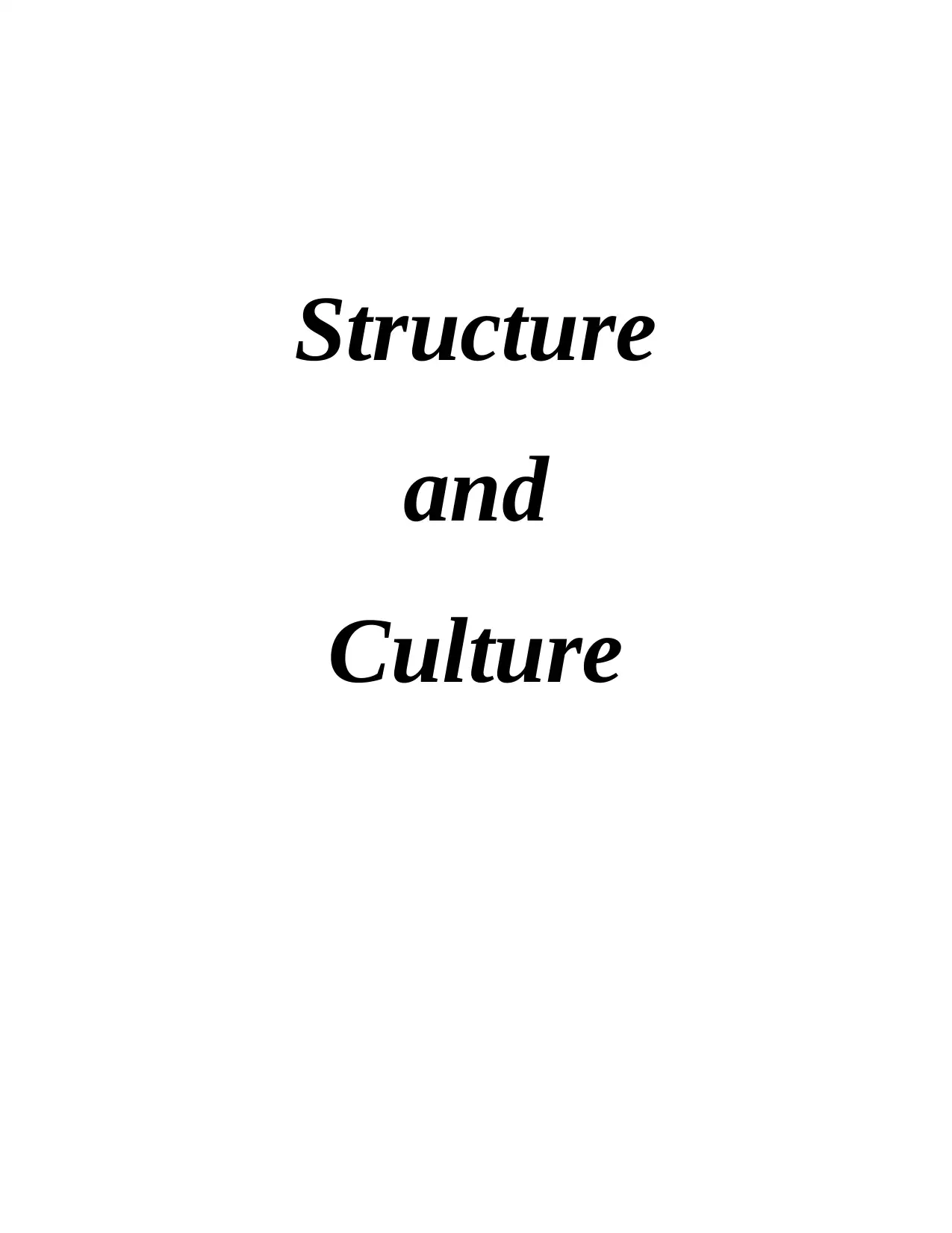
Structure
and
Culture
and
Culture
Paraphrase This Document
Need a fresh take? Get an instant paraphrase of this document with our AI Paraphraser
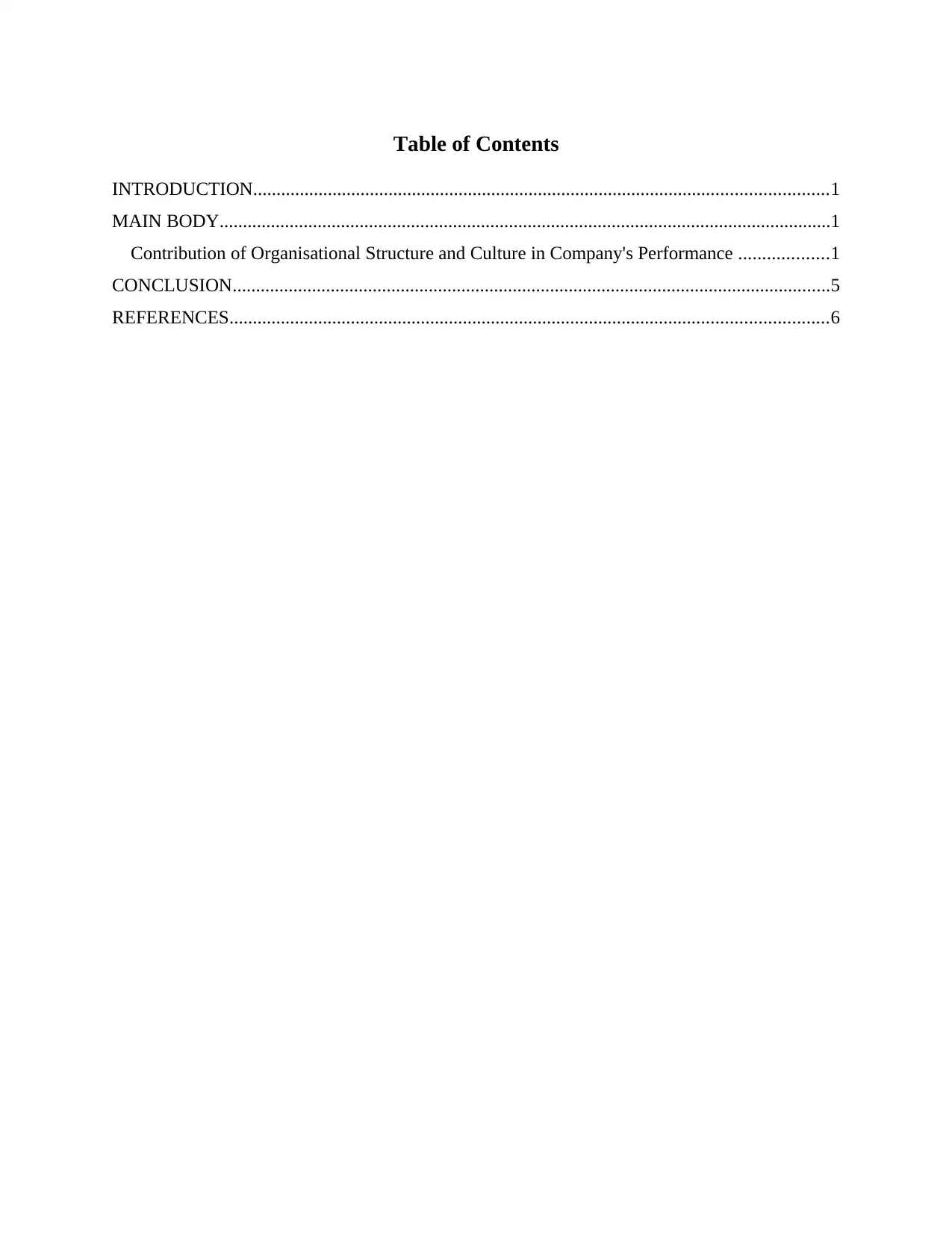
Table of Contents
INTRODUCTION...........................................................................................................................1
MAIN BODY...................................................................................................................................1
Contribution of Organisational Structure and Culture in Company's Performance ...................1
CONCLUSION................................................................................................................................5
REFERENCES................................................................................................................................6
INTRODUCTION...........................................................................................................................1
MAIN BODY...................................................................................................................................1
Contribution of Organisational Structure and Culture in Company's Performance ...................1
CONCLUSION................................................................................................................................5
REFERENCES................................................................................................................................6
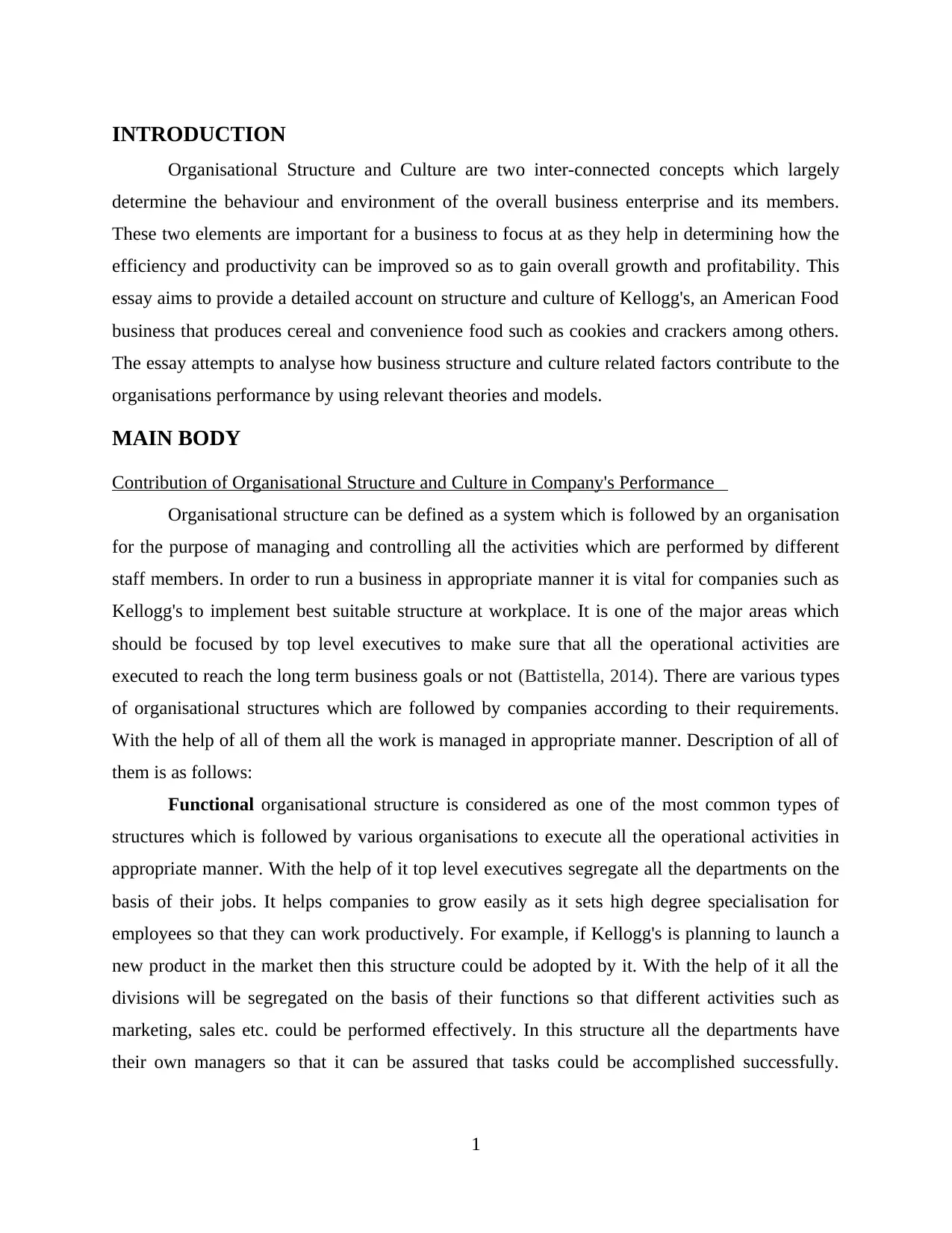
INTRODUCTION
Organisational Structure and Culture are two inter-connected concepts which largely
determine the behaviour and environment of the overall business enterprise and its members.
These two elements are important for a business to focus at as they help in determining how the
efficiency and productivity can be improved so as to gain overall growth and profitability. This
essay aims to provide a detailed account on structure and culture of Kellogg's, an American Food
business that produces cereal and convenience food such as cookies and crackers among others.
The essay attempts to analyse how business structure and culture related factors contribute to the
organisations performance by using relevant theories and models.
MAIN BODY
Contribution of Organisational Structure and Culture in Company's Performance
Organisational structure can be defined as a system which is followed by an organisation
for the purpose of managing and controlling all the activities which are performed by different
staff members. In order to run a business in appropriate manner it is vital for companies such as
Kellogg's to implement best suitable structure at workplace. It is one of the major areas which
should be focused by top level executives to make sure that all the operational activities are
executed to reach the long term business goals or not (Battistella, 2014). There are various types
of organisational structures which are followed by companies according to their requirements.
With the help of all of them all the work is managed in appropriate manner. Description of all of
them is as follows:
Functional organisational structure is considered as one of the most common types of
structures which is followed by various organisations to execute all the operational activities in
appropriate manner. With the help of it top level executives segregate all the departments on the
basis of their jobs. It helps companies to grow easily as it sets high degree specialisation for
employees so that they can work productively. For example, if Kellogg's is planning to launch a
new product in the market then this structure could be adopted by it. With the help of it all the
divisions will be segregated on the basis of their functions so that different activities such as
marketing, sales etc. could be performed effectively. In this structure all the departments have
their own managers so that it can be assured that tasks could be accomplished successfully.
1
Organisational Structure and Culture are two inter-connected concepts which largely
determine the behaviour and environment of the overall business enterprise and its members.
These two elements are important for a business to focus at as they help in determining how the
efficiency and productivity can be improved so as to gain overall growth and profitability. This
essay aims to provide a detailed account on structure and culture of Kellogg's, an American Food
business that produces cereal and convenience food such as cookies and crackers among others.
The essay attempts to analyse how business structure and culture related factors contribute to the
organisations performance by using relevant theories and models.
MAIN BODY
Contribution of Organisational Structure and Culture in Company's Performance
Organisational structure can be defined as a system which is followed by an organisation
for the purpose of managing and controlling all the activities which are performed by different
staff members. In order to run a business in appropriate manner it is vital for companies such as
Kellogg's to implement best suitable structure at workplace. It is one of the major areas which
should be focused by top level executives to make sure that all the operational activities are
executed to reach the long term business goals or not (Battistella, 2014). There are various types
of organisational structures which are followed by companies according to their requirements.
With the help of all of them all the work is managed in appropriate manner. Description of all of
them is as follows:
Functional organisational structure is considered as one of the most common types of
structures which is followed by various organisations to execute all the operational activities in
appropriate manner. With the help of it top level executives segregate all the departments on the
basis of their jobs. It helps companies to grow easily as it sets high degree specialisation for
employees so that they can work productively. For example, if Kellogg's is planning to launch a
new product in the market then this structure could be adopted by it. With the help of it all the
divisions will be segregated on the basis of their functions so that different activities such as
marketing, sales etc. could be performed effectively. In this structure all the departments have
their own managers so that it can be assured that tasks could be accomplished successfully.
1
⊘ This is a preview!⊘
Do you want full access?
Subscribe today to unlock all pages.

Trusted by 1+ million students worldwide
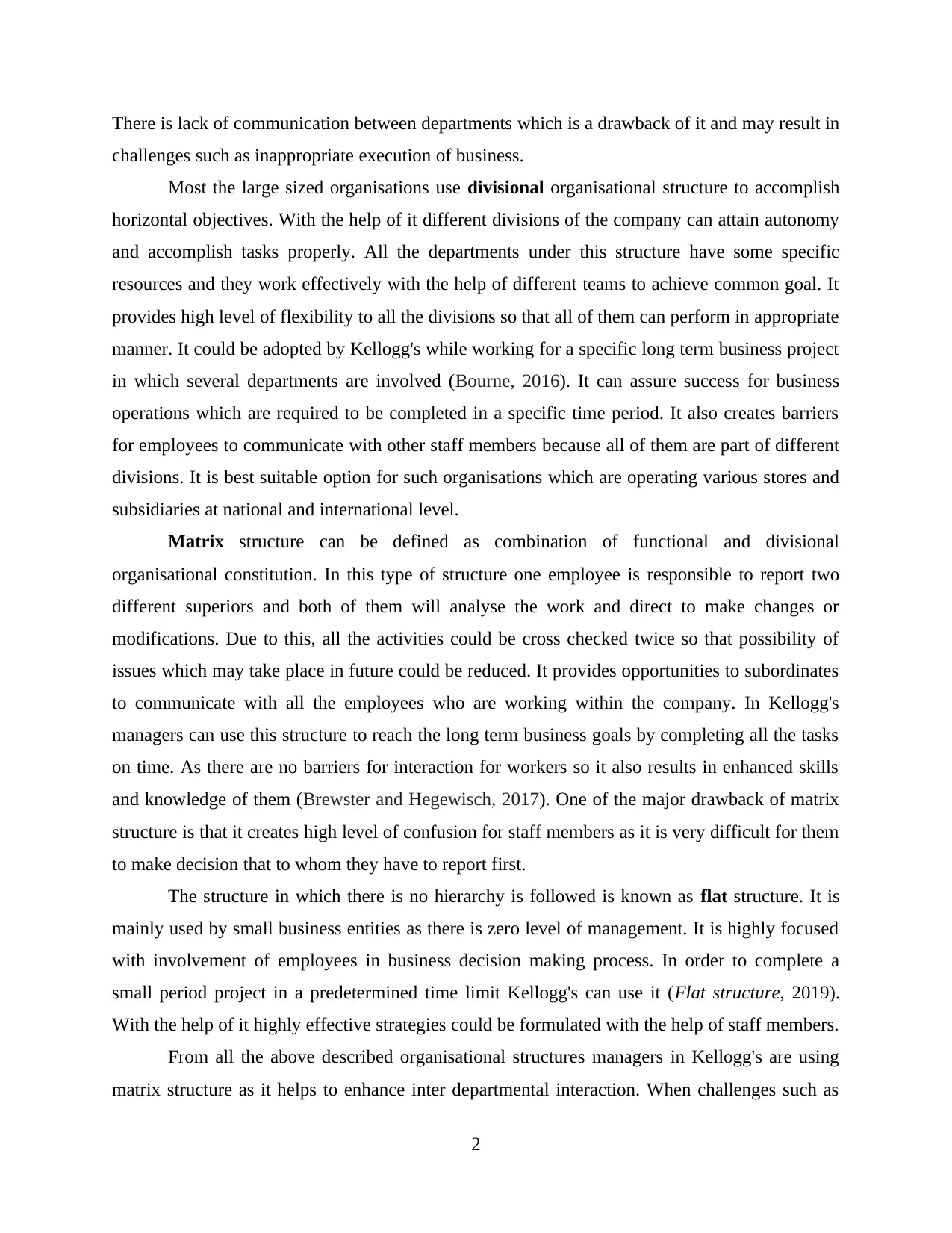
There is lack of communication between departments which is a drawback of it and may result in
challenges such as inappropriate execution of business.
Most the large sized organisations use divisional organisational structure to accomplish
horizontal objectives. With the help of it different divisions of the company can attain autonomy
and accomplish tasks properly. All the departments under this structure have some specific
resources and they work effectively with the help of different teams to achieve common goal. It
provides high level of flexibility to all the divisions so that all of them can perform in appropriate
manner. It could be adopted by Kellogg's while working for a specific long term business project
in which several departments are involved (Bourne, 2016). It can assure success for business
operations which are required to be completed in a specific time period. It also creates barriers
for employees to communicate with other staff members because all of them are part of different
divisions. It is best suitable option for such organisations which are operating various stores and
subsidiaries at national and international level.
Matrix structure can be defined as combination of functional and divisional
organisational constitution. In this type of structure one employee is responsible to report two
different superiors and both of them will analyse the work and direct to make changes or
modifications. Due to this, all the activities could be cross checked twice so that possibility of
issues which may take place in future could be reduced. It provides opportunities to subordinates
to communicate with all the employees who are working within the company. In Kellogg's
managers can use this structure to reach the long term business goals by completing all the tasks
on time. As there are no barriers for interaction for workers so it also results in enhanced skills
and knowledge of them (Brewster and Hegewisch, 2017). One of the major drawback of matrix
structure is that it creates high level of confusion for staff members as it is very difficult for them
to make decision that to whom they have to report first.
The structure in which there is no hierarchy is followed is known as flat structure. It is
mainly used by small business entities as there is zero level of management. It is highly focused
with involvement of employees in business decision making process. In order to complete a
small period project in a predetermined time limit Kellogg's can use it (Flat structure, 2019).
With the help of it highly effective strategies could be formulated with the help of staff members.
From all the above described organisational structures managers in Kellogg's are using
matrix structure as it helps to enhance inter departmental interaction. When challenges such as
2
challenges such as inappropriate execution of business.
Most the large sized organisations use divisional organisational structure to accomplish
horizontal objectives. With the help of it different divisions of the company can attain autonomy
and accomplish tasks properly. All the departments under this structure have some specific
resources and they work effectively with the help of different teams to achieve common goal. It
provides high level of flexibility to all the divisions so that all of them can perform in appropriate
manner. It could be adopted by Kellogg's while working for a specific long term business project
in which several departments are involved (Bourne, 2016). It can assure success for business
operations which are required to be completed in a specific time period. It also creates barriers
for employees to communicate with other staff members because all of them are part of different
divisions. It is best suitable option for such organisations which are operating various stores and
subsidiaries at national and international level.
Matrix structure can be defined as combination of functional and divisional
organisational constitution. In this type of structure one employee is responsible to report two
different superiors and both of them will analyse the work and direct to make changes or
modifications. Due to this, all the activities could be cross checked twice so that possibility of
issues which may take place in future could be reduced. It provides opportunities to subordinates
to communicate with all the employees who are working within the company. In Kellogg's
managers can use this structure to reach the long term business goals by completing all the tasks
on time. As there are no barriers for interaction for workers so it also results in enhanced skills
and knowledge of them (Brewster and Hegewisch, 2017). One of the major drawback of matrix
structure is that it creates high level of confusion for staff members as it is very difficult for them
to make decision that to whom they have to report first.
The structure in which there is no hierarchy is followed is known as flat structure. It is
mainly used by small business entities as there is zero level of management. It is highly focused
with involvement of employees in business decision making process. In order to complete a
small period project in a predetermined time limit Kellogg's can use it (Flat structure, 2019).
With the help of it highly effective strategies could be formulated with the help of staff members.
From all the above described organisational structures managers in Kellogg's are using
matrix structure as it helps to enhance inter departmental interaction. When challenges such as
2
Paraphrase This Document
Need a fresh take? Get an instant paraphrase of this document with our AI Paraphraser
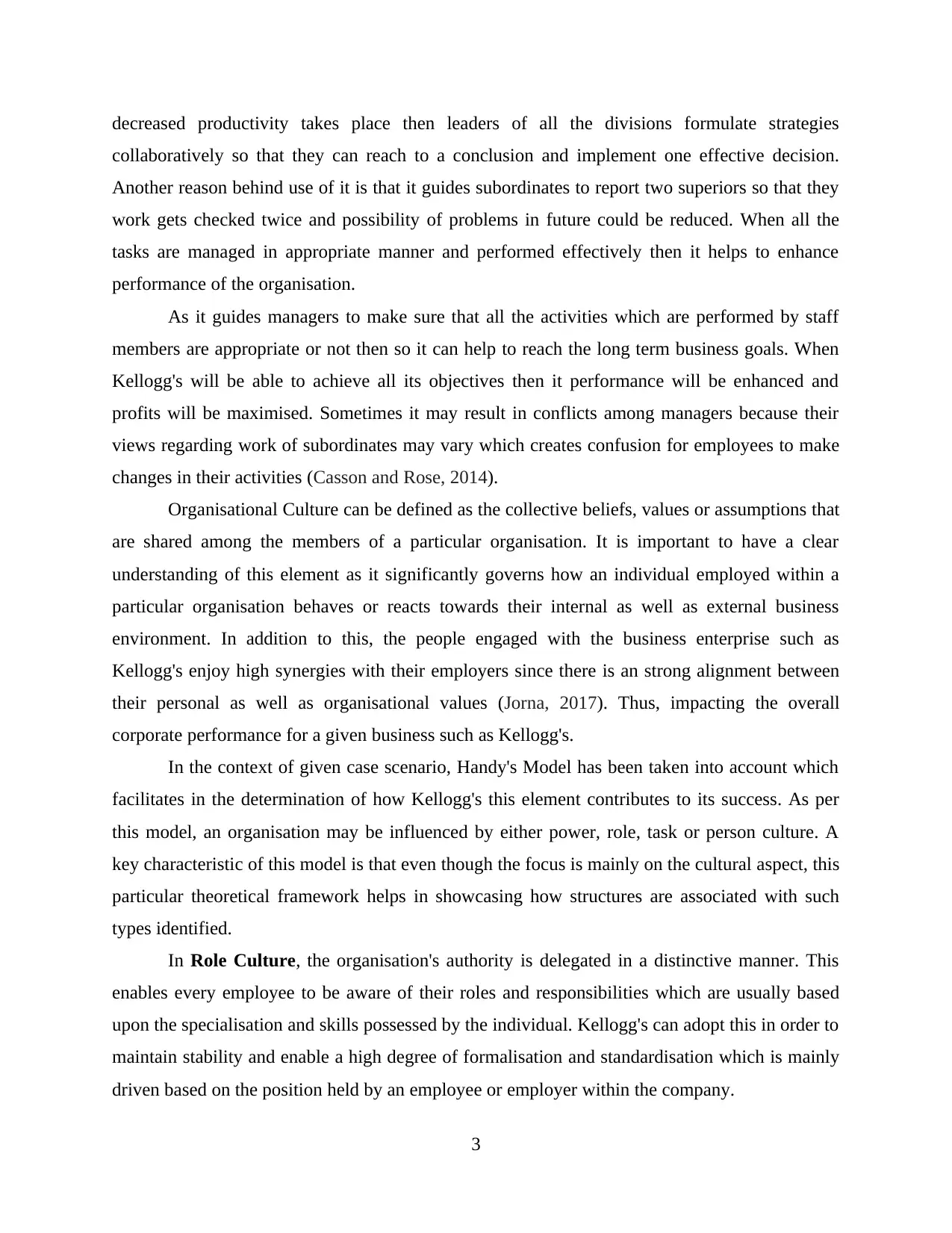
decreased productivity takes place then leaders of all the divisions formulate strategies
collaboratively so that they can reach to a conclusion and implement one effective decision.
Another reason behind use of it is that it guides subordinates to report two superiors so that they
work gets checked twice and possibility of problems in future could be reduced. When all the
tasks are managed in appropriate manner and performed effectively then it helps to enhance
performance of the organisation.
As it guides managers to make sure that all the activities which are performed by staff
members are appropriate or not then so it can help to reach the long term business goals. When
Kellogg's will be able to achieve all its objectives then it performance will be enhanced and
profits will be maximised. Sometimes it may result in conflicts among managers because their
views regarding work of subordinates may vary which creates confusion for employees to make
changes in their activities (Casson and Rose, 2014).
Organisational Culture can be defined as the collective beliefs, values or assumptions that
are shared among the members of a particular organisation. It is important to have a clear
understanding of this element as it significantly governs how an individual employed within a
particular organisation behaves or reacts towards their internal as well as external business
environment. In addition to this, the people engaged with the business enterprise such as
Kellogg's enjoy high synergies with their employers since there is an strong alignment between
their personal as well as organisational values (Jorna, 2017). Thus, impacting the overall
corporate performance for a given business such as Kellogg's.
In the context of given case scenario, Handy's Model has been taken into account which
facilitates in the determination of how Kellogg's this element contributes to its success. As per
this model, an organisation may be influenced by either power, role, task or person culture. A
key characteristic of this model is that even though the focus is mainly on the cultural aspect, this
particular theoretical framework helps in showcasing how structures are associated with such
types identified.
In Role Culture, the organisation's authority is delegated in a distinctive manner. This
enables every employee to be aware of their roles and responsibilities which are usually based
upon the specialisation and skills possessed by the individual. Kellogg's can adopt this in order to
maintain stability and enable a high degree of formalisation and standardisation which is mainly
driven based on the position held by an employee or employer within the company.
3
collaboratively so that they can reach to a conclusion and implement one effective decision.
Another reason behind use of it is that it guides subordinates to report two superiors so that they
work gets checked twice and possibility of problems in future could be reduced. When all the
tasks are managed in appropriate manner and performed effectively then it helps to enhance
performance of the organisation.
As it guides managers to make sure that all the activities which are performed by staff
members are appropriate or not then so it can help to reach the long term business goals. When
Kellogg's will be able to achieve all its objectives then it performance will be enhanced and
profits will be maximised. Sometimes it may result in conflicts among managers because their
views regarding work of subordinates may vary which creates confusion for employees to make
changes in their activities (Casson and Rose, 2014).
Organisational Culture can be defined as the collective beliefs, values or assumptions that
are shared among the members of a particular organisation. It is important to have a clear
understanding of this element as it significantly governs how an individual employed within a
particular organisation behaves or reacts towards their internal as well as external business
environment. In addition to this, the people engaged with the business enterprise such as
Kellogg's enjoy high synergies with their employers since there is an strong alignment between
their personal as well as organisational values (Jorna, 2017). Thus, impacting the overall
corporate performance for a given business such as Kellogg's.
In the context of given case scenario, Handy's Model has been taken into account which
facilitates in the determination of how Kellogg's this element contributes to its success. As per
this model, an organisation may be influenced by either power, role, task or person culture. A
key characteristic of this model is that even though the focus is mainly on the cultural aspect, this
particular theoretical framework helps in showcasing how structures are associated with such
types identified.
In Role Culture, the organisation's authority is delegated in a distinctive manner. This
enables every employee to be aware of their roles and responsibilities which are usually based
upon the specialisation and skills possessed by the individual. Kellogg's can adopt this in order to
maintain stability and enable a high degree of formalisation and standardisation which is mainly
driven based on the position held by an employee or employer within the company.
3

Under Power Culture, the senior management influences the spreads throughout the
organisation. Here, the rules and regulations are formulated by the top-level authority
themselves. It can be defined as set of web which is spread out from central to various nodes of
the organisation. However, such organisations are prevalent of politics which is a direct resultant
of persuasion practices followed within such enterprises. As a result, employee performance is
reviewed based on their achievements rather than their behaviour. Kellogg's can adopt this so as
to enable a practice of quick decision-making within the business as there are less number of
people holding this privilege within the enterprise (Macnaghten and Chilvers, 2014).
In Task Culture, a job or project-oriented approach is adopted across all organisational
levels which usually boast of a matrix or project-based structural design. Since it is job-based,
the resources are allocated based on the tasks provided among various teams. For Kellogg's, its
adoption can enable the company to unify power of the group which can result in improving
efficiency, flexibility and innovation which helps them to ward off competition successfully.
Under Person Culture, individual goals are prioritised over organisational ones. As a
result, the existence of the company is to merely serve the purpose of providing assistance to
their achievement of individual objectives. Usually, such type of cultures are commonly found in
the form of Professional Partnerships whereby influence is mutual and the power-base is usually
expertise-driven. As a result, there is high degree of specialisation present within the
organisation which enables the workforce to grow in the way they aspire to. Kellogg's can
undertake this if it wants to motivate their employees to pursue their personal aspirations and
help them grow by providing them a well-established platform (Shafritz, Ott and Jang, 2015).
Kellogg's has adopted a task culture in order to enable its day-to-day activities to be
highly flexible and inviting for the employees. By adopting this element of Handy's Model, the
company has been able to inculcate an environment which is classified into various task groups.
Through this, the organisation has been able to harness the power of specialisation which enables
the company to take decisions in a prompt manner as well as ensures that the morale of
employees does not falter at any given point of time. In addition to this, as task culture induces
flexibilty, Kellogg's is able to enjoy a system of business processes that can easily adapt to its
continuously changing business environment. This is important since the industry in which the
business operates is highly competitive in nature. Additionally, Kellogg's is also able to combine
a right match of skills, personalities, leadership and knowledge which encourages an
4
organisation. Here, the rules and regulations are formulated by the top-level authority
themselves. It can be defined as set of web which is spread out from central to various nodes of
the organisation. However, such organisations are prevalent of politics which is a direct resultant
of persuasion practices followed within such enterprises. As a result, employee performance is
reviewed based on their achievements rather than their behaviour. Kellogg's can adopt this so as
to enable a practice of quick decision-making within the business as there are less number of
people holding this privilege within the enterprise (Macnaghten and Chilvers, 2014).
In Task Culture, a job or project-oriented approach is adopted across all organisational
levels which usually boast of a matrix or project-based structural design. Since it is job-based,
the resources are allocated based on the tasks provided among various teams. For Kellogg's, its
adoption can enable the company to unify power of the group which can result in improving
efficiency, flexibility and innovation which helps them to ward off competition successfully.
Under Person Culture, individual goals are prioritised over organisational ones. As a
result, the existence of the company is to merely serve the purpose of providing assistance to
their achievement of individual objectives. Usually, such type of cultures are commonly found in
the form of Professional Partnerships whereby influence is mutual and the power-base is usually
expertise-driven. As a result, there is high degree of specialisation present within the
organisation which enables the workforce to grow in the way they aspire to. Kellogg's can
undertake this if it wants to motivate their employees to pursue their personal aspirations and
help them grow by providing them a well-established platform (Shafritz, Ott and Jang, 2015).
Kellogg's has adopted a task culture in order to enable its day-to-day activities to be
highly flexible and inviting for the employees. By adopting this element of Handy's Model, the
company has been able to inculcate an environment which is classified into various task groups.
Through this, the organisation has been able to harness the power of specialisation which enables
the company to take decisions in a prompt manner as well as ensures that the morale of
employees does not falter at any given point of time. In addition to this, as task culture induces
flexibilty, Kellogg's is able to enjoy a system of business processes that can easily adapt to its
continuously changing business environment. This is important since the industry in which the
business operates is highly competitive in nature. Additionally, Kellogg's is also able to combine
a right match of skills, personalities, leadership and knowledge which encourages an
4
⊘ This is a preview!⊘
Do you want full access?
Subscribe today to unlock all pages.

Trusted by 1+ million students worldwide
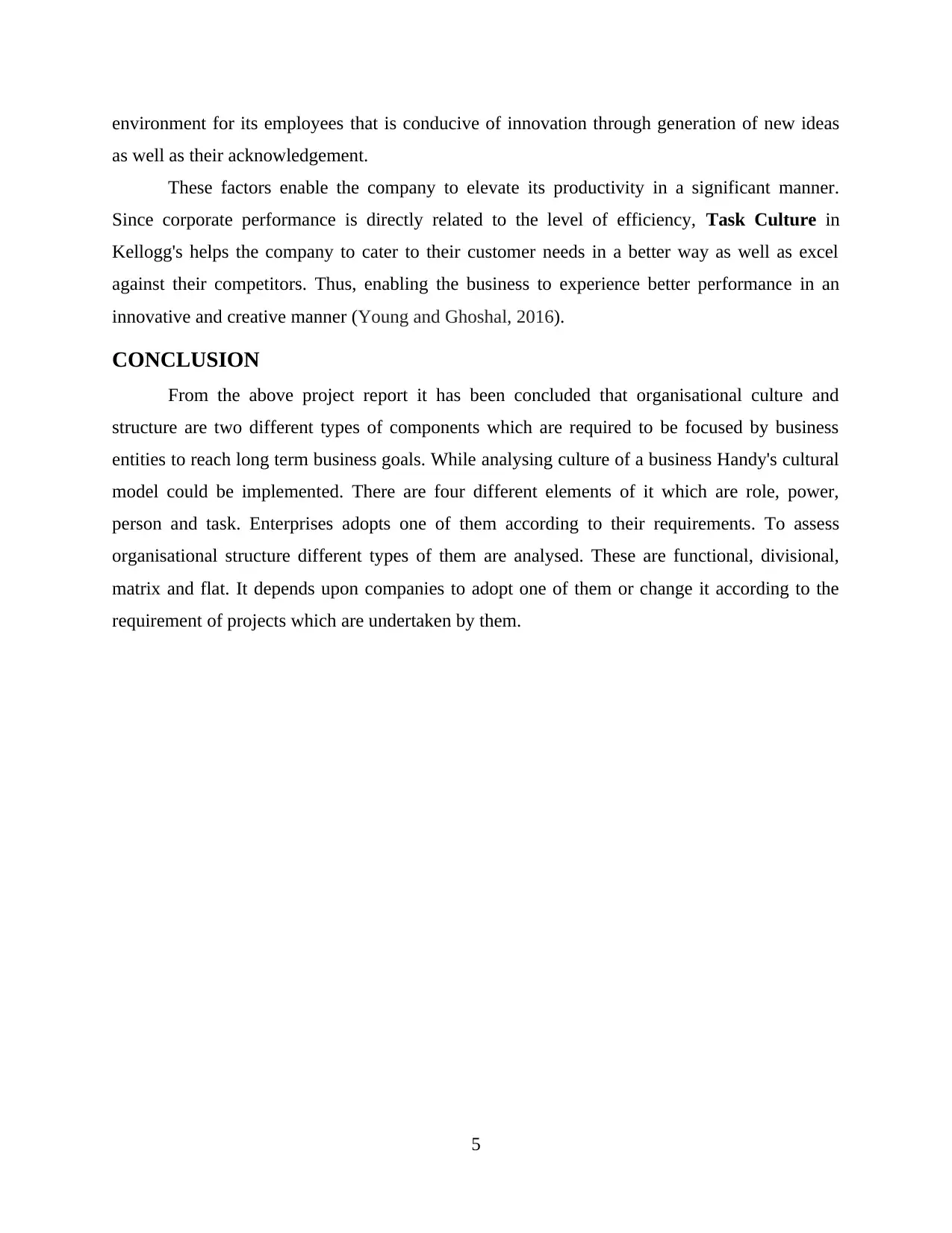
environment for its employees that is conducive of innovation through generation of new ideas
as well as their acknowledgement.
These factors enable the company to elevate its productivity in a significant manner.
Since corporate performance is directly related to the level of efficiency, Task Culture in
Kellogg's helps the company to cater to their customer needs in a better way as well as excel
against their competitors. Thus, enabling the business to experience better performance in an
innovative and creative manner (Young and Ghoshal, 2016).
CONCLUSION
From the above project report it has been concluded that organisational culture and
structure are two different types of components which are required to be focused by business
entities to reach long term business goals. While analysing culture of a business Handy's cultural
model could be implemented. There are four different elements of it which are role, power,
person and task. Enterprises adopts one of them according to their requirements. To assess
organisational structure different types of them are analysed. These are functional, divisional,
matrix and flat. It depends upon companies to adopt one of them or change it according to the
requirement of projects which are undertaken by them.
5
as well as their acknowledgement.
These factors enable the company to elevate its productivity in a significant manner.
Since corporate performance is directly related to the level of efficiency, Task Culture in
Kellogg's helps the company to cater to their customer needs in a better way as well as excel
against their competitors. Thus, enabling the business to experience better performance in an
innovative and creative manner (Young and Ghoshal, 2016).
CONCLUSION
From the above project report it has been concluded that organisational culture and
structure are two different types of components which are required to be focused by business
entities to reach long term business goals. While analysing culture of a business Handy's cultural
model could be implemented. There are four different elements of it which are role, power,
person and task. Enterprises adopts one of them according to their requirements. To assess
organisational structure different types of them are analysed. These are functional, divisional,
matrix and flat. It depends upon companies to adopt one of them or change it according to the
requirement of projects which are undertaken by them.
5
Paraphrase This Document
Need a fresh take? Get an instant paraphrase of this document with our AI Paraphraser
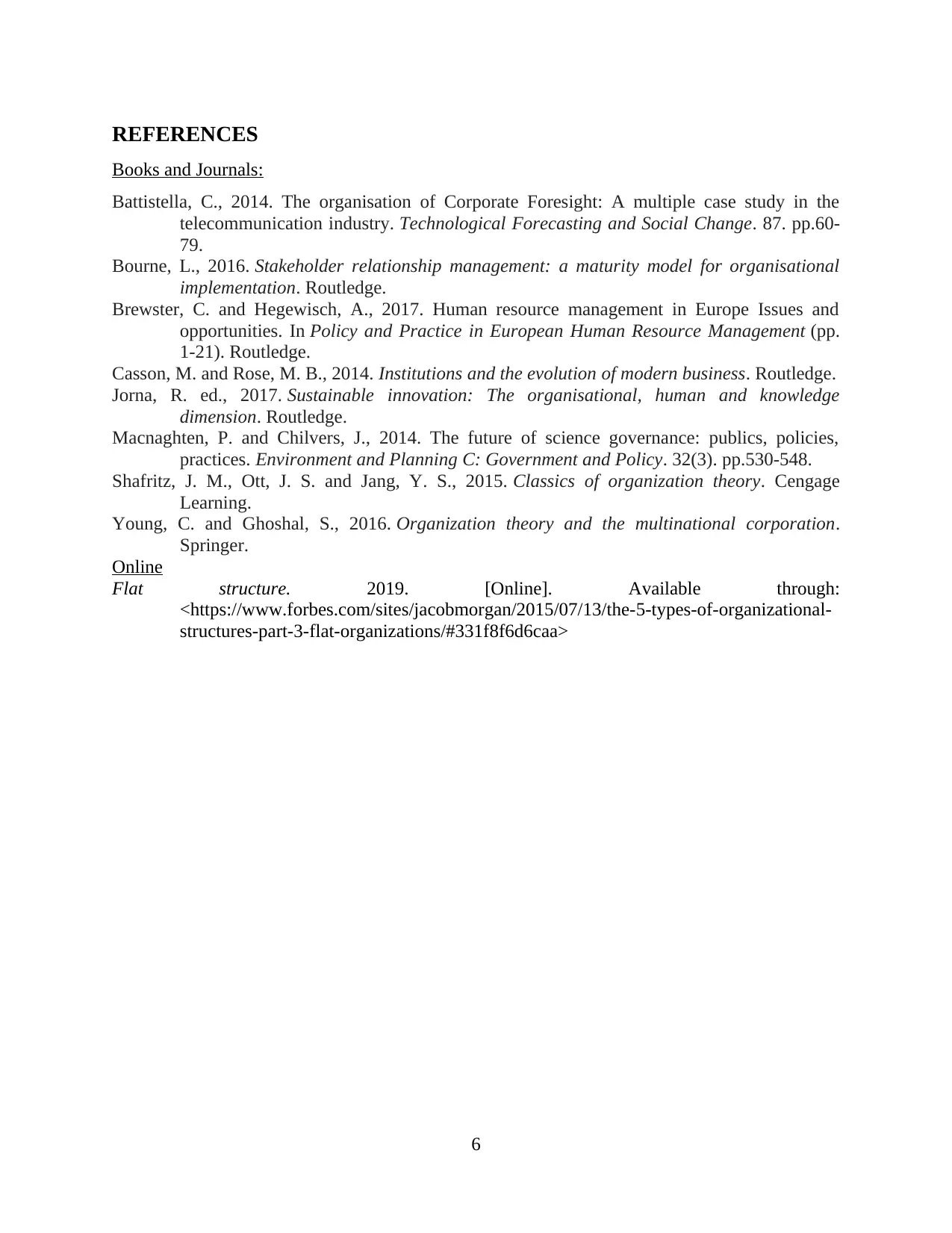
REFERENCES
Books and Journals:
Battistella, C., 2014. The organisation of Corporate Foresight: A multiple case study in the
telecommunication industry. Technological Forecasting and Social Change. 87. pp.60-
79.
Bourne, L., 2016. Stakeholder relationship management: a maturity model for organisational
implementation. Routledge.
Brewster, C. and Hegewisch, A., 2017. Human resource management in Europe Issues and
opportunities. In Policy and Practice in European Human Resource Management (pp.
1-21). Routledge.
Casson, M. and Rose, M. B., 2014. Institutions and the evolution of modern business. Routledge.
Jorna, R. ed., 2017. Sustainable innovation: The organisational, human and knowledge
dimension. Routledge.
Macnaghten, P. and Chilvers, J., 2014. The future of science governance: publics, policies,
practices. Environment and Planning C: Government and Policy. 32(3). pp.530-548.
Shafritz, J. M., Ott, J. S. and Jang, Y. S., 2015. Classics of organization theory. Cengage
Learning.
Young, C. and Ghoshal, S., 2016. Organization theory and the multinational corporation.
Springer.
Online
Flat structure. 2019. [Online]. Available through:
<https://www.forbes.com/sites/jacobmorgan/2015/07/13/the-5-types-of-organizational-
structures-part-3-flat-organizations/#331f8f6d6caa>
6
Books and Journals:
Battistella, C., 2014. The organisation of Corporate Foresight: A multiple case study in the
telecommunication industry. Technological Forecasting and Social Change. 87. pp.60-
79.
Bourne, L., 2016. Stakeholder relationship management: a maturity model for organisational
implementation. Routledge.
Brewster, C. and Hegewisch, A., 2017. Human resource management in Europe Issues and
opportunities. In Policy and Practice in European Human Resource Management (pp.
1-21). Routledge.
Casson, M. and Rose, M. B., 2014. Institutions and the evolution of modern business. Routledge.
Jorna, R. ed., 2017. Sustainable innovation: The organisational, human and knowledge
dimension. Routledge.
Macnaghten, P. and Chilvers, J., 2014. The future of science governance: publics, policies,
practices. Environment and Planning C: Government and Policy. 32(3). pp.530-548.
Shafritz, J. M., Ott, J. S. and Jang, Y. S., 2015. Classics of organization theory. Cengage
Learning.
Young, C. and Ghoshal, S., 2016. Organization theory and the multinational corporation.
Springer.
Online
Flat structure. 2019. [Online]. Available through:
<https://www.forbes.com/sites/jacobmorgan/2015/07/13/the-5-types-of-organizational-
structures-part-3-flat-organizations/#331f8f6d6caa>
6
1 out of 8
Related Documents
Your All-in-One AI-Powered Toolkit for Academic Success.
+13062052269
info@desklib.com
Available 24*7 on WhatsApp / Email
![[object Object]](/_next/static/media/star-bottom.7253800d.svg)
Unlock your academic potential
Copyright © 2020–2025 A2Z Services. All Rights Reserved. Developed and managed by ZUCOL.





